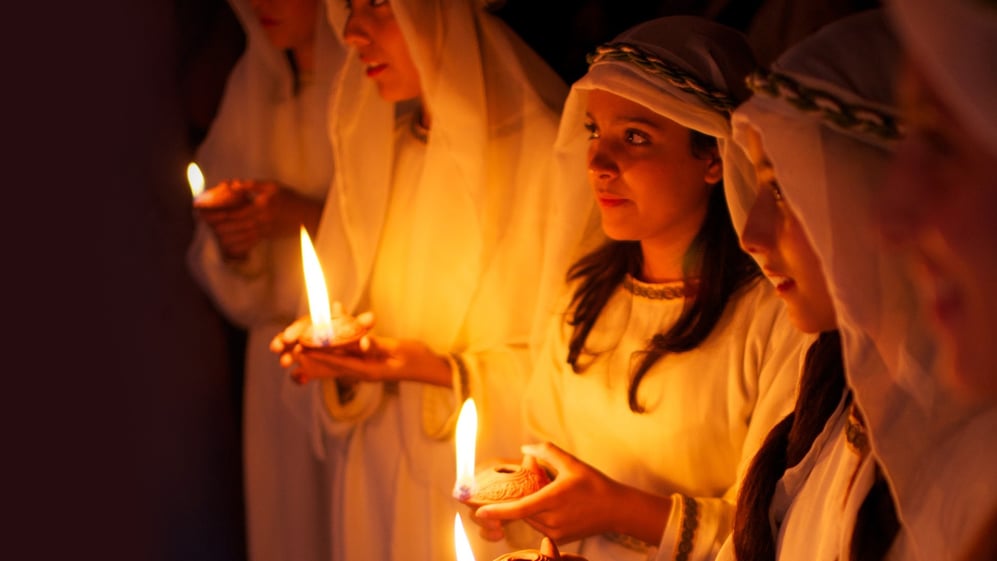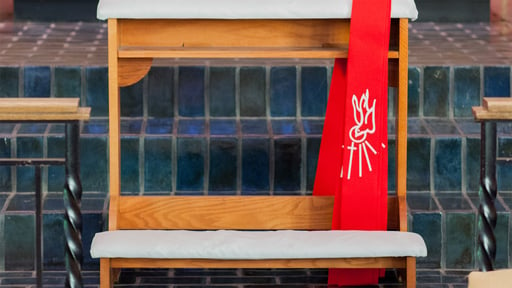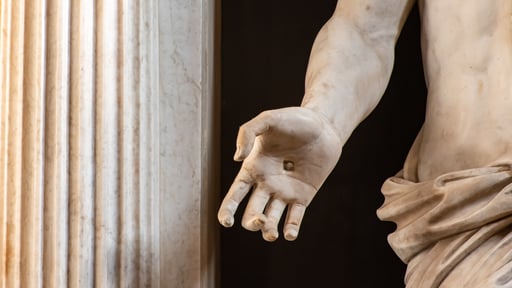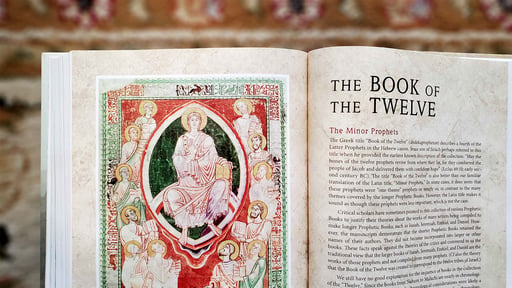On November 8, 15, and 22, the three Sundays between All Saints’ Day and the First Sunday in Advent, the Gospel readings from the three-year lectionary cover the entirety of Matthew 25. This chapter is about the return of Jesus and the end of the world. In a way, these three Sundays serve as a sort of pre-Advent season that focuses (much like Advent) on the hope and expectation of Jesus’ return.
To better understand Matthew 25, we must look back at Matthew 24. Matthew 24–25 comprise what is known as the Olivet Discourse or the Eschatological Discourse. For a more in-depth treatment of this section, I highly recommend Jeffrey A. Gibbs’s commentary Matthew 21:1–28:20. And if you really want to dig deeper into these two chapters in particular, Gibbs’s monograph Jerusalem and Parousia: Jesus’ Eschatological Discourse in Matthew’s Gospel is absolute gold.
As Jesus leaves the temple (24:1), the disciples point out the buildings of the temple. Jesus tells them, “There will not be left here one stone upon another that will not be thrown down” (24:2). Jesus and the disciples head up to the Mount of Olives, which looks down on Jerusalem and the temple. There, the disciples ask Jesus two questions.
- “Tell us when will these things [the destruction of the temple referenced in 24:2] be?”
- “What will be the sign of Your coming and the end of the age?”
Jesus answers the first question in 24:4–35. Jesus answers the second question in 24:36–25:46. As one preaches or teaches on any of the three readings from Matthew 25, it is important to keep the disciples’ questions in mind from 24:3, as well as the beginning of Jesus’ answer to the second question: “Concerning that day and hour no one knows, not even the angels of heaven nor the Son, but the Father only” (24:36).
The collective point of these three readings is simple. Nobody knows the day or the hour of Jesus’ return except the Father; therefore, be ready.
Matthew 25:1–13: The Parable of the Ten Virgins
Of note in this parable is the relationship between the wise and foolish virgins. The wise bring extra oil so that they will be ready even if the bridegroom (Jesus) is delayed. The foolish do not bring extra oil, so they are not ready for the arrival of the bridegroom. All of them become drowsy and fall asleep. At midnight comes the cry, “Here is the bridegroom! Come out to meet him.” Roused from sleep, the wise fill and trim their lamps to prepare to welcome and honor the bridegroom. The foolish risk dishonoring the bridegroom by trying to take the oil from the wise, but the wise prevent this, knowing how shameful it would be for no one to be there when the bridegroom came. The foolish go to buy more oil, and the bridegroom comes as they are gone.
The wise naturally honor the bridegroom out of love for him by preparing to meet him, no matter when he comes. The foolish fail to honor the bridegroom by not being ready for him and even risk dishonoring him in order to cover their own failures.
The parable boils down to this: nobody knows the day or the hour of the bridegroom’s (Jesus’) return. You cannot get ready for it. You can only be ready for it. Honor Jesus by being ready.
Matthew 25:14–30: The Parable of the Talents
Although there are three servants in this parable, there are only two types of servants. While the previous parable contrasts the wise versus foolish, this parable contrasts the good and faithful versus the wicked, slothful, and worthless.
The master entrusts his treasures to each of the servants. Notice how these servants view their master. The good and faithful servants trust that their master is likewise good and faithful. They understand his identity and character as we do—full of love, mercy, and grace. These servants go forth at once in joy to multiply their master’s treasures.
On the other hand, the wicked and slothful servant does not recognize or care for the master’s trust in him. He misunderstands the master’s character and identity. Notice, the wicked servant is the only one who characterizes the master negatively. This wicked servant is called slothful and claims he is afraid, but laziness and fear are merely symptoms of the servant’s true problem. This servant hates his master. He does not want his master’s treasures to improve. His master’s treasures are worthy of nothing more than carelessly being buried in the ground and forgotten about until it is too late.
This servant makes excuses related to fear of the master, but the master points out the obvious. If this servant was merely fearful and wanted to play it safe, he would have invested these treasures with the bankers to earn interest. The wicked servant’s guilt resides in doing nothing, which is quite different than not doing enough. For God’s people, the warning in this text is not in how much we do, but the warning resides in how dangerous it is to lose sight of God’s identity and character and treat Him with contempt and hatred.
Again, the point of the parable is connected to 24:36. No one knows the day or the hour of Jesus’ return. Those who stand ready for His return love Him and are naturally faithful with what He has entrusted to them. Those who are not ready for Jesus’ return are those who hate Him and treat Him and His gifts with contempt.
Matthew 25:31–46: The Consummation of the Age
The final reading from Matthew 25 is certainly challenging. At the end of the age, when Jesus returns, He will separate the sheep from the goats. The sheep go to eternal life, the goats to eternal punishment.
Our interpretation hinges on the phrase uttered in verse 40: “As you did it to one of the least of these My brothers, you did it to Me.”
The most common misinterpretation of this passage is one that is influenced by a “salvation by works” mentality. It turns the good works of our hospitality into the basis for our salvation or damnation. The Scriptures command us to take care of those who are less fortunate (the widow, the orphan, the sojourner, and the poor), to show hospitality, but these good works (or any good works for that matter) are never the basis for salvation in the Scriptures. These things are good and necessary for showing love to our neighbors, but they cannot earn us salvation.
Notice the connections to Matthew 10 and Matthew 28 here. In Matthew 10, the twelve disciples are sent to heal, cast out demons, raise the dead, and proclaim the reign and rule of God. Those who do not receive the disciples and their message (and thereby the one who sent them—Jesus) are cursed on the Day of Judgment with a harsher judgment than Sodom and Gomorrah (Matthew 10:14–15). Later in the chapter, Jesus says to His disciples, “Whoever receives you receives Me, and whoever receives Me receives Him who sent Me” (Matthew 10:40).
Likewise, in Matthew 28:10, Jesus refers to His disciples as “My brothers” and later in the chapter sends them to continue the mission of disciple creation by baptizing and teaching all nations, strengthened by His presence.
As Gibbs argues in his commentary, “the least of these My brothers” refers to Jesus’ disciples. In Matthew 25, as all the nations are gathered before His throne (25:32), Jesus will separate the sheep and the goats. The sheep are those who receive those whom Jesus sent, and therefore, received Jesus’ words and work. The saved sheep are those who believe the Gospel, the Good News of Jesus’ death and resurrection for them. The goats are those who rejected the ones whom Jesus sent and, therefore, rejected Jesus’ words and work. The condemned goats are those who reject the Gospel and Jesus.
Again, the point of this section is straightforward. No one knows when Jesus is returning, so be ready by hearing and receiving Jesus, His Word, and His messengers with joy.
Scripture: ESV®.
To read about the last judgment as seen in these passages, get the Matthew 20:1–28:20 Concordia Commentary.






.jpg?width=50&height=50&name=IMG_20220621_160541_456%20(1).jpg)








